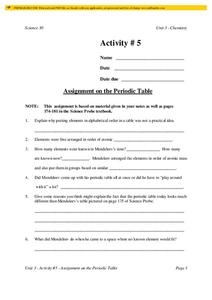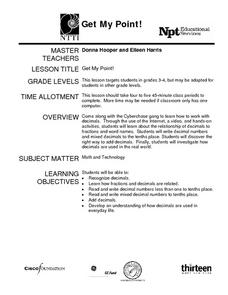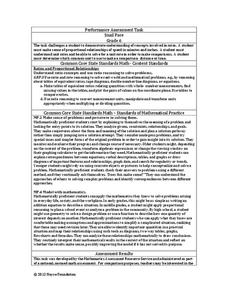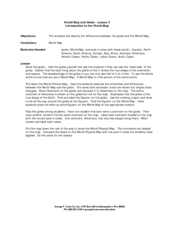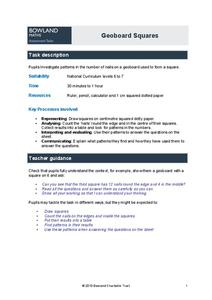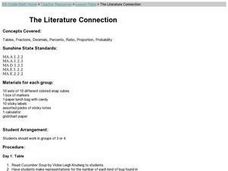Curated OER
Words to Numbers
Seventh graders translate word problems into numerical expressions. Through guided practice, 7th graders discover how to take the information contained in a word problem and create a numerical expression using variables. They...
Curated OER
Periodic Table
In this periodic table worksheet, young scholars determine why the periodic table is organized the way it is and compare and contrast the characteristics of the different grouping of elements. This worksheet has 22 short answer and 36...
Curated OER
Time to Five Minutes
In this math worksheet, students tell the difference between the hour and minute hands on a clock. They tell the time on four analog clocks to the nearest five minutes.
Curated OER
Intro to Polynomials
Seventh graders participate in a lesson introducing the mathematical concept of polynomials. They are asked questions and assessed according to the answers given during working in small groups.
Curated OER
Children in Hiding During the Holocaust
Students examine the different ways in which children hid trying to escape the concentration camps. Using journal entries, they put themselves into the role of the children and imagine their feelings during the Holocaust. They discuss...
Curated OER
Bar Graphs With Intervals
Give your math class a comprehensive understanding of bar graphs with this series of lessons. The resource is divided into three parts, and all of the accompanying worksheets are included. The class will study different bar graphs,...
Curated OER
Prepositions
After reviewing the different purposes of prepostions and many examples, the class can practice using them in sentences. While little direction is provided in the plan, this is a fantastic resource for teachers looking for a simple...
Curated OER
Keying Rocks
Young geologists learn how to use an identification key in order to classify rocks. The key is designed to help them classify rocks into three types: ignesous, metamorphic, and sediimentary. After an initial teacher-led demonstration,...
Curated OER
Get My Point!
Here is one of the better lessons I've come across on how to teach fractions and decimals. This instructional activity does a great job of showing how these two mathematical representations of numbers are interrelated. Some excellent...
Noyce Foundation
Snail Pace
Slow and steady wins the race? In the assessment task, scholars calculate the rates at which different snails travel in order to find the fastest snail. Hopefully, your class will move much more quickly in finishing the task!
Curated OER
Introduction to the World Globe
Students examine a globe and the world map to see what constitutes the differences. In this world map introductory lesson, students discuss what they see when they view the globe. Students then, look at a world map and compare the...
Curated OER
The Artist as Entrepreneur: Getting Down to Business: What's My Market?
Students create a marketing plan for their artwork by analyzing their potential customers. They consider the type of art they wish to produce, the price range for the art and the type of competition that they face then develop a low...
Curated OER
Savings
Young scholars investigate the different ways to save money and the reasons for doing so. They use addition, subtraction, multiplication, and division (with whole numberrs, fractions, decimals, and/or percents, mixed numbers) to solve...
Mathematics Vision Project
Geometric Figures
Logical thinking is at the forefront of this jam-packed lesson, with young mathematicians not only investigating geometric concepts but also how they "know what they know". Through each activity and worksheet, learners wrestle with...
Mathematics Vision Project
Module 3: Polynomial Functions
An informative module highlights eight polynomial concepts. Learners work with polynomial functions, expressions, and equations through graphing, simplifying, and solving.
Indiana Science
How Many E’s?
Seventh graders explore random sampling by estimating the number of e's on the newspaper. They explain the possible error sources for this type of sampling, and compare the accuracy of sampling a small and large population. This is a...
Bowland
Geoboard Squares
Don't be a square! Help your budding mathematicians discover patterns within squares. Scholars create squares on geoboards and identify patterns in the number of nails, both nails on the edge of the squares and nails within the squares....
Curated OER
Writing Equations From Patterns
In this writing equations worksheet, 9th graders solve and complete 6 different problems that include various patterns. First, they read and identify relations of equations and the difference between successive values of x and y. Then,...
Curated OER
Find the Pairs
Students practice finding matching pairs of words to review their vocabulary terms. They complete a worksheet and then cut it up into twenty four pieces to shuffle and then separate into matching pairs with a partner given to them by the...
Curated OER
It's About Time
In this time worksheet, learners match the clock or watch with the time in numbers. Students complete 6 matching problems total.
Curated OER
The Literature Connection
Second graders read Cucumber Soup by Vickie Leigh. They make representations for the number of each kind of bug found in the book. This lesson is a terrific way to show students how fractions, decimals and percents are related.
Curated OER
Your Local Area
Young scholars investigate the meaning of regional differences as they study a survey written about the different ways people like to eat chips and design and make a poster to show what makes their area unique.
Curated OER
Unit 2 Section 2: Prime Factors
In this prime factors worksheet, learners make six factor trees. They tell the prime factorization for eight numbers. Students answer three questions regarding the prime factorization of numbers.
Curated OER
Make 6!
For this addition practice worksheet, 3rd graders use colored counters to show the number 6 in 3 different ways in the spaces provided.

